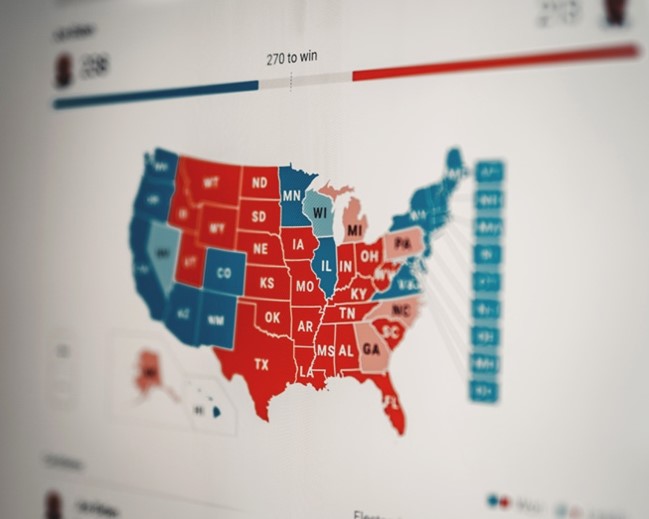Even when presented with the same information, liberals and conservatives tend to interpret political information differently. By measuring brain activity while partisans watched political videos or thought about political concepts, we show that individuals that are similar in their political beliefs exhibit similar brain patterns whilst processing political information.
Over the past 30 years, the ideological divide has grown wider, and negative feelings between ideologues have strengthened. Despite this pressing issue we do not have a good understanding of the neurobiology of political polarization. Given prior research showing that holding different beliefs can lead to a different interpretation of the same information, we investigated whether sharing a political ideology is associated with more similar brain processing—and thus interpretations—of political content.
We invited 22 conservative and 22 liberal participants from the US to complete two different tasks while we recorded their brain activity using functional Magnetic Resonance Imaging. First, they completed a basic word reading task, in which they were presented with different politically charged words (for example ‘immigration’ and ‘abortion’) and instructed to think about the word. We also asked them to rate how similar each word was to all the other words they were presented with (e.g., how similar is abortion to immigration). Next, they watched two real-world political videos: an excerpt of the CNN 2016 Vice-Presidential debate on immigration and policing, and an PBS NewsHour item on abortion legislation.
To investigate how political ideology influences political information processing, we first wanted to see whether we could find ideology related differences in how people rated the similarity between words. Participants that were more similar in their political ideology—regardless of whether they were at the more conservative or more liberal side of the political spectrum—rated a certain subset of the political words as more similar to one another. This was reflected at the neural level: shared political ideology predicted similar brain activity patterns in brain regions linked to valuation and perspective taking for words perceived as similar. That is, the brains of likeminded individuals represented abstract political words, such as immigration, in similar ways. This helps explain why those with opposing political views think differently about political topics.
In the real world, however, political information is not consumed by reading just one word in isolation. We therefore wanted to test how these static word representations influence actual political information consumption. More specifically, we wanted to test whether the brain’s response to a political word like abortion can be linked to the brain’s activity when a news reporter is describing abortion related issue. We found that in brain regions linked to perspective taking and emotional processing, more similar brain patterns for a specific political word predicted more similar brain patterns during a political video on the same topic—for those who share a political ideology. Put simply, political ideology shapes the brain’s response to political concepts, and these concepts predict how people interpret real-world political information.
We also found evidence of a second mechanism that seems to underline political polarization. As we move about the world, we are constantly bombarded by a continuous stream of information. Much like a book is broken up into sentences, paragraphs, and chapters, our brains must segment incoming information into meaningful chunks, a process called ‘temporal segmentation’. We hypothesized that partisan differences might be linked to how an individual chunks or segments incoming information, which might explain why we see such stark interpretations of the same information. We found exactly that—those on the left side of the political aisle segment the political videos in the same way, but differently from those on the right.
Taken together, our research suggests that how the brain responds to political information governs whether two individuals will have diverging political interpretations. Indeed, political ideology had an impact on multiple different brain processes: 1) the representation of political words, 2) the response to real dynamic political videos, and 3) the way we chunk political information into meaningful units. That we find these effects in brain regions often linked to emotional processing and perspective taking also helps to explain the rise in negative feelings and the increased difficulty of collaboration between those with opposing political views. By gaining a better understanding of how political polarization arises, we can start focusing on how to best intervene, which will hopefully lead to better communication and cooperation in the future.
Original Article:
de Bruin, D., van Baar, J. M., Rodríguez, P. L., & FeldmanHall, O. (2023). Shared neural representations and temporal segmentation of political content predict ideological similarity. Science Advances, 9(5), eabq5920. https://doi.org/10.1126/sciadv.abq5920
 Psychology
Psychology



